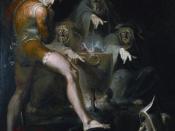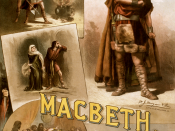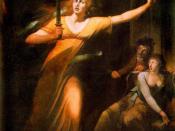William Shakespeare's tragic play Macbeth is set in 11th-century Scotland. The overarching political system then was feudalism, a system that was "based on the holding of land" and placed "an increasing emphasis on local protection, local government, and local self-sufficiency" (World History, Section 9-4, pp. 214 **). Shakespeare, however, lived during the late 16th and early 17th century, a time in which kings with "absolute authority" and "divine right" (W.H, Section 18-3, pp. 430) ruled a strongly centralized nation. His plays naturally revealed his preference of a strong centralized monarchy over a feudal government, which was stable but outdated. Therefore, Macbeth, arguably Shakespeare's most political play, reflects a seemingly stable feudal system full of subtle weaknesses while simultaneously showing the trend towards centralization and foreshadowing the future Age of Kings.
In accord with the setting of the play, the customs and titles held by the characters in Macbeth reflect feudal traditions and clearly reveal a feudal government.
The main tenet of feudalism is the exchange of vows, described by Galbert of Bruges: "The count asked if he was willing to become completely his man, and the other replied: 'I am willing;' [...] Afterward...[the count] gave investiture to...who by this agreement had given his...oath" (Sources, Section 7-7, pg. 216). The count gives his vassal a reward in return for loyalty. In Macbeth, Duncan condemns the traitorous Thane of Cawdor to death and simultaneously gives Macbeth a second fief for his victory in battle (Macbeth, Act 1, Scene 3, ll. 74-76). These actions are a disguised and cunning attempt to ensure or strengthen the unwavering loyalty of Duncan's vassals. Macbeth replies by stating that "your Highness' part is to receive our duties...safe toward your love and honor" (Macbeth, Act 1, Scene 4, ll. 26-27). This dialogue itself illustrates a subtle 'exchange of...


